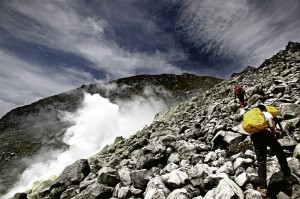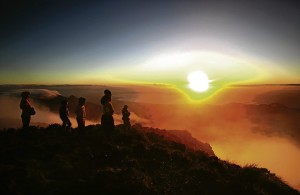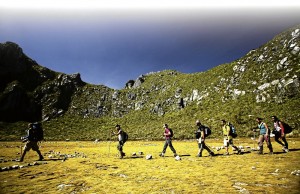There’s much more to Davao than Mt. Apo
Getting a bigger bite from the tourism pie, Davao now draws a surging stream of adventure seekers and nature lovers from both here and abroad as it positions itself as the country’s main ecotourism site.
Davao, located at the southeast part of Mindanao, is blessed to have Mt. Apo to shower the region with an abundance of natural resources.
The challenging climb to the Philippines’ highest peak traverses through creeks, ridges, boulders and waterfalls with an amazing panorama of rainforest and fauna, making it the province’s top tourist destination.
The province also offers extreme sports like white water rafting in Davao river; ziplining in Zip City, the longest zipline in Asia; wakeboarding in Deca wakeboard park, the first cable wakeboarding facility in Mindanao; and diving in Davao Pearl Farm.
Other ecotourism sites are various mountain resorts in Samal and Marilog District, tubing site in Sta. Cruz, and Crocodile Park in Ma-a.
Whether it is for adventure or to simply smell the flowers, Davao is a dream destination for all nature lovers.
“If you look at the figures for Davao City, compared from 2011 to 2012, there’s been an increase of 10 percent at least in terms of arrivals, both foreign and domestic,” says Department of Tourism Davao regional director Art Boncato Jr.
The system in the region in counting tourist arrivals is by way of hotel occupancy.
The town of Sta. Cruz—a gateway to Mt. Apo—only has a few home stay and few resorts, so many tourists of the town really stay in Davao City, explains Boncato.
Boncato says there is a continuing growth in tourist arrivals. Based on their annual report, visitors in Davao City reached 700,000 in 2011 from the last year’s 670,000. The bulk of the tourists are domestic travelers while among the foreign markets came from the United States, Japan and Korea.
He adds that the mushrooming of new hotels in Davao City is an indication of an active economy.
Comparing from 2000, tourist arrivals have increased to about 500,000 in 2011. Boncato attributes the increase to strong domestic promotions and cheaper air fare.
Part of the efforts of Davao to boost tourism is by coming up with an adventure race to showcase Mt. Apo’s rich biodiversity.
Recently, the 2nd International Mt. Apo Boulder Face Challenge was formally launched by the DOT Region XI and the municipal government of Sta. Cruz. The 24-hour race-to-the-peak challenge aims to promote Davao region as a leading destination for eco-adventure tourism.
The extreme sport challenge, slated on April 28-29, will be a major highlight of the annual “Pista sa Kinaiyahan” (Feast for the Environment) celebration of Sta. Cruz.
Boncato says the Boulder Challenge has made Davao Region, where a major portion of Mt. Apo is located, the leading destination for eco-adventure tourism. Formerly a local race, they have decided to promote it as an international event to bring in more foreign tourists.
The continued success of the Boulder Challenge encourages more people to visit their province and at the same time a big help in their conservation program of the country’s highest peak.
“Aside from ecotourism, the local government is also working very hard to promote Davao as a destination for meetings and conventions. So dumami rin ung conventions so dumami rin ung mga tao,” shares Boncato.
In April this year, DOT Davao is preparing to host an airline industry forum in Davao City. The convention aims to gather all airport authorities, airline companies and CEOs in order to draw up plans and to fast-track linkages with Brunei Darussalam, Indonesia, Malaysia, Philippines-East Asean Growth Area. Boncato said some 200 CEOs are expected to participate in the conference.
Boncato points out that showcasing Mt. Apo as a destination for adventure races also opens new doors for destinations surrounding it. The tourists of Davao City are also offered to go beyond. Vacationers could also visit Samal Island which is in Davao del Norte, and also Sta. Cruz in Davao del Sur.
“Last year’s tourist arrival in Sta. Cruz alone were around 5,000-6,000, both foreign and local tourists. But for the entire Davao region, particularly in the city, it is very substantial. That’s why there’s an increase in the establishment of hotels and lodging houses in Davao city,” says Mayor Joel Ray Lopez of Sta. Cruz, Davao del Sur.
Lopez also attributes the steady increase of tourists to the Boulder Challenge. Not only did the tourists keep on coming in Sta. Cruz but also the concern for conservation is also enhanced.
As the tourism in the Davao region continues to flourish, more investors are now seeing its potential to be the next tourist destination in the country.
“Davao now has 5,000 rooms, and in the next two years another 5,000 more rooms are to be built to accommodate the increase in influx of tourists,” says Lopez.
Meanwhile, a number of infrastructure projects are targeted to rise in the near future. SMX Davao, an 8,000-square-meter world-class facility, is expected to bring in more conventions in the future and open more jobs for the province.
Through promoting Mt. Apo’s natural resources, more companies are now discovering the mountain’s abundant supply of renewal energy.
“Hedcor Inc. of the Aboitiz group is given the permit to utilize the water from Mt. Apo which is the source of renewal energy for the generation of hydropower,” says Mayor Lopez.
Hedcor Inc., a leading producer of clean and renewable energy in the Philippines, is already operating a 42.5 MW hydroelectric power plant in the Sibulan and Baroring Rivers, which supply electricity to Davao Light and Power Company.
“Our biggest investor this year is the Aboitiz Power. Aside from expanding another 15 MW in their hydroelectric power plant, they are also in the process of putting up a 300 MW coal-fired power plant,” says Lopez.
According to Lopez, Aboitiz Power already has an existing investment of P6-8 billion, and it is investing P24 billion more for the planned coal-fired power plant.
“There is also an application from the Ayala group in partnership with Mitsubishi to put up a 35 MW solar power project they are now working on for the approval from the DOE. Hopefully, it will push through,” says Lopez.
The Aboitiz project is estimated to be completed within four years. These investments on energy projects are expected to boost the economy and augment the supply needs of the province.



